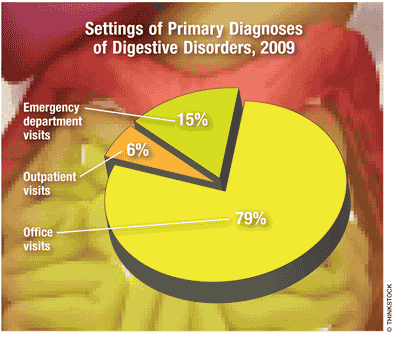US Pharm. 2012;37(12):Epub.
Digestive disorders affected 60 to 70 million Americans in 2009, resulting in 13.5 million hospitalizations and almost 105 million ambulatory-care visits. More than three-fourths of patients with a digestive disorder as the primary diagnosis sought medical care at a physician’s office, whereas one-fifth visited the emergency department (ED). Diagnostic and therapeutic inpatient procedures were performed on 5.5 million patients with digestive disorders (12% of all inpatient procedures), and ambulatory surgical procedures were performed during 20 million visits (31% of all ambulatory procedures). Digestive disorders cost nearly $142 billion, with 69% (~$98 billion) accounting for direct medical costs and $44 billion accounting for indirect costs such as disability and mortality. Of all digestive disorders, irritable bowel syndrome generated the greatest number of prescriptions (~6 million), closely followed by chronic constipation (>5 million) and peptic ulcer (5 million); fewer than 1 million prescriptions each were written for gastrointestinal infections, pancreatitis, and liver disease.

Hospital Patients: National Hospital Ambulatory Medical Care Survey data for 2009 reveal that roughly 45 ED visits (136 million) were made for every 100 persons. Digestive disorders were the fifth most common reason for an ED visit (8 million) and were the primary diagnosis in 80% of cases. Complaints of stomach pain, cramps, and spasms, which were reported for 7% of all ED visits, were made by 3.4% more males than females aged 15 years and younger, and by 28.4% more women than men older than 65 years. The number of hospitalizations for gastroesophageal reflux disease (GERD) nearly equaled the total number of hospitalizations for diverticulitis, chronic constipation, gallstones, peptic ulcer, and liver disease combined. Digestive disorders as the primary diagnosis constituted the third most frequent reason (3.4 million) for visiting the outpatient department.
Ambulatory Patients: National Ambulatory Medical Care Survey data show that digestive disorders were the ninth-ranked primary diagnosis (42.3 million) in roughly 4% of all office visits. Stomach pain, cramps, and spasms, the principal reasons for office visits, were reported by nearly 16 million people (1.5% of all office visits), with females outnumbering males (1.7% vs. 1.2%). Write-in procedures ordered or performed at office visits for digestive disorders exceeded 25 million, accounting for nearly 26% of all write-in procedures. Chronic constipation affected 63 million people, generating 6.3 million ambulatory-care visits and 5.3 million prescriptions. Abdominal-wall hernia was responsible for 4.7 million ambulatory-care visits and 3.7 million prescriptions. About 2 million people had diverticular disease, which generated more than 3 million ambulatory-care visits and nearly 3 million prescriptions. GERD (~37%) was the most common reason for ambulatory-care visits for digestive disorders; chronic constipation was a distant second at nearly 13%.
To comment on this article, contact rdavidson@uspharmacist.com.






